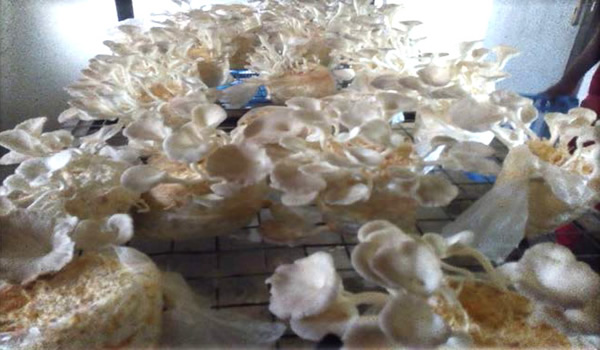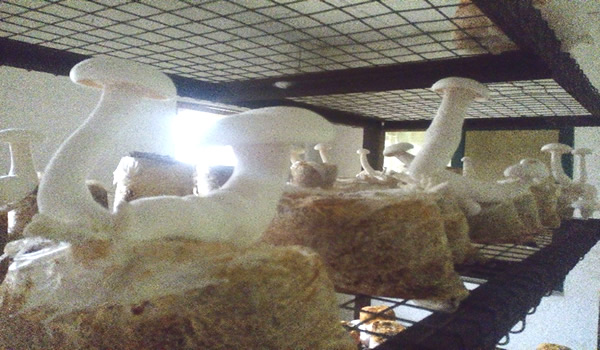 Waste Utilization and Fermentation Division is one of the pioneer Divisions of the Biotechnology Department of Federal Institute of Industrial Research, Oshodi, Nigeria.
Waste Utilization and Fermentation Division is one of the pioneer Divisions of the Biotechnology Department of Federal Institute of Industrial Research, Oshodi, Nigeria. Among the core mandates of the Division are:
1· To conduct research and development activities that lead to the conversion of wastes (mainly agricultural wastes) into wealth creation.
2· To carry out research and development activities that employ current fermentation techniques to produce goods and services that will benefit Nigerians in particular and humanity at large.
3· To liaise with other Departments and Divisions within the Institute to disseminate the R & D findings to Nigerians through Seminars/Symposium/Workshop.
Vision of the Division:
The vision of the Division is to be a reference centre within the West African sub-region where wastes (mainly agricultural wastes) are harnessed into useful forms through the application of basic biotechnological tools.
On-going Research Projects
- Mushroom programme
Ïsolation and cultivation of edible mushroom – Auricularia species and calocybe indica
- Development of Mushroom enriched Ogi
- Survey of Edible and Medicinal mushroom species in Nigeria.
- Conversion of spent mushroom substrate into biofertilizer.
- Development of Local Technology for production of bakers yeasts
- Microbial production of venegar using local raw materials
Developed Available Technologies
1. Commercial cultivation of indigenous edible mushrooms
2. Upgrade and Standardization of production process of some indigenous fermented foods e.g. Ugba.
MUSHROOM CULTIVATION IN NIGERIA.
THE PAST
FIIRO has been the forerunner in the cultivation of Mushrooms in Nigeria. The project started as far back as 1988. Though people find it hard to believe that mushrooms can be cultivated in-door because people are of the opinion that mushrooms grow naturally in the wild and apart from that, eating mushrooms from the wild gives concern to the public for the fear of eating poisonous species. The advent of FIIRO in mushroom cultivation has changed the face of mushrooms in Nigeria using agro-industrial wastes. Some of the wastes FIIRO has used in the past are cotton waste, sawdust, corn cob, cassava peels, banana leaves, groundnut shell, wood shavings, cassava flour shaft etc. FIIRO has also supplemented some of these wastes that have a low yield such as wood shavings, corn cob, cassava peels, cassava flour shaft with poultry manure, palm kernel cake, rice bran, wheat bran etc to increase their yield which gave a positive result.
The wastes have been supportive in the cultivation of Pleurotus tuberregium, Pleurotus pulmonarius, Lentinus sqaurrosulus, Volvariella volvacea and Pleurotus ostreatus. Spawns of these mushrooms are all available at the mushroom culture bank. These mushrooms have been grown to commercial stage in FIIRO using different wastes from the six-geopolitical zones.
THE PRESENT
Presently, FIIRO has gone beyond laboratory cultivation. Effort is now being geared towards commercial cultivation of mushrooms to make them available to the public and increase the people’s awareness. FIIRO is also striving to increase the protein intake of Nigerians believed to be very low, especially the low income earners that cannot afford the expensive protein from meat, milk and so on. The use of cotton waste in the past for its high yield compared to other agro-wastes relegated these wastes to the background but with the scarcity of cotton waste, new technology has been developed for the use of sawdust. This is supplemented with rice bran, wheat bran or palm kernel cake which now gives yield better than cotton waste. New species of mushrooms are being sourced for everyday to increase species of mushroom cultured and give Nigerians variety of mushrooms to savior.
Training of small and medium scale entrepreneurs has also been part of FIIRO’s effort in making sure that Nigerians cultivate the habit of eating mushroom. The SMEs were trained in the art of mushroom cultivation making use agro-industrial wastes.
THE FUTURE
With the pace FIIRO is going in creating awareness, training of SME’s, future of mushroom in Nigeria is going to be great. It will be another source of income to the country earning, creating job for the unemployed youth and improve the nutritional intake of Nigerians by eating mushrooms and increase the immune systems by eating mushrooms. Also the commercial cultivation in the Institute will be source of income apart from the sale of spawns.
In the area of bio-remediation, mushrooms have been discovered to be a veritable tool in the cleaning of our environment, the use of wastes for the cultivation reduces land pollution while the mushroom mycelia also has been worked upon and discovered to be useful in biodegradation of toxic chemicals and spilled crude oil.
The Institute has used the following wastes extensively to cultivate mushroom: Cotton waste, sawdust, rice bran, cassava peel, yam peel, sugarcane bagasse, wheat bran corn cob, sawdust, cassava peel, yam peel, cotton waste, wheat bran, groundnut shells, rice straw etc and have mixed the substrates to increases yields of the mushroom fruits.
At the Federal Institute of Industrial Research, Oshodi (FIIRO) several techniques have been adapted for the cultivation of the mushroom which thrives in the temperature range of 28-36oC and relative humidity of 75-88%.
The table below shows summary of wastes and their mushroom yields.
MUSHROOM CULTIVATION SUBSTRATES AND YIELD
|
S/N |
GROWING MEDIUM |
MUSHROOM SPECIES |
PERCENTAGE YIELD |
|
1 |
Rice straw |
Straw (Volvariella) Oyster (Pleurotus) |
26% 65% |
|
2 |
Wheat Bran |
Oyster (Pleurotus) Straw (Volvariella) |
68% 20% |
|
3 |
Sawdust |
Lentinus |
|
|
4 |
Sawdust/PKC |
Oyster (Pleurotus) Oyster (Pleurotus) |
50% 70% |
|
5 |
Cotton Waste |
Oyster (Pleurotus) Straw (Volvariella) |
80% 26% |
|
6 |
Corncobs |
Oyster (Pleurotus) Lentinus |
60% |
|
7 |
Paper |
Oyster (Pleurotus) |
14.9 |
|
8 |
Sugarcane Bigasse |
Oyster (Pleurotus) |
22 |
|
9 |
Water Hyacinth |
Oyster (Pleurotus) |
15 |
|
10 |
Oil Palm Waste |
Straw (Volvariella) Oyster (Pleurotus) |
- |
|
11 |
Cocoa Shell Waste |
Oyster (Pleurotus) Oyster (Pleurotus) |
20% |
|
12 |
Banana leaves |
Straw (Volvariella) Oyster (Pleurotus) |
30% |
|
13 |
Cassava peel |
Oyster (Pleurotus) |
27% |
|
14 |
Yam peel |
Oyster (Pleurotus) |
- |
|
15 |
Cassava peel/Soybean Chaff |
Oyster (Pleurotus) |
72 |
(ii) Available mushrooms
FIIRO has worked on the isolation and cultivation of different species of mushrooms which include:
Pleurotus tuberregium
Pleurotus pulmonarius
Pleurotus ostreatus
Volvariella volvacea
Lentinus squarroslus
Cantharellus lateritius
Culture of these mushrooms can be gotten from the Biotechnology Department of the Federal Institute of Industrial Research, Oshodi.
New species on our bench work are Auricularia auricular and Calocybe indica. Spawn of these species can be produced and purchased on request.
Substrates
FIIRO has been able to work on the following industrial agro-wastes:-
Cotton waste, Sawdust, Cassava peels, Yam peels, Groundnut shell, Banana leaves, Corn cob, Wood shavings, Wheat bran, Rice bran, Water hyacinth, etc. It has been discovered that of all these substrates, cotton waste gives the highest yield singly. However, due to many more uses of cotton waste and thereby scarcity, FIIRO began to look inwards and came up with the new concept for the use of sawdust which is a good competitor of cotton waste. Rice bran and Wheat bran are used as supplement when using sawdust and wood shavings.
The other wastes have been used singly or mixed in multiple and some of these have proven to be effective for cultivation. Some agro wastes were also gotten from the Northern part of the country in FIIRO’s bid to make sure that all parts of the country can benefit from her research work. These wastes include Millet stovers, Millet husk, Benin seed husk, Dusa industrial waste, Guinea corn stovers, Guinea corn husk, Rice shaft, Beans pod and Maize offal’s. These wastes were found to give average yield when used singly.
Spawn production
Spawn production is carried out exclusively by microbiologists and is produced in sterile environment. Substrates used for spawn production are cotton waste, sorghum grains, corn and sawdust. Cotton waste has been discovered to ramify faster than all the other substrates but sorghum does better on cultivated substrates.


Contact the Division:
Okorie, Princewill Chimezie (PhD)
Food and Industrial Microbiologist
Deputy Director (Waste Utilization & Fermentation Division)
M.Sc Applied Microbiology
E-mail: This email address is being protected from spambots. You need JavaScript enabled to view it.; This email address is being protected from spambots. You need JavaScript enabled to view it.
Phone number: +234(01)8053514782
